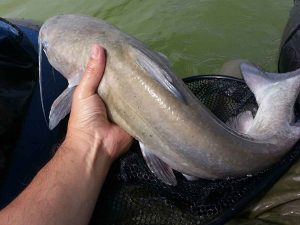Believe it nor not, it’s already late summer – we’re got less than a month left, officially – and for many anglers, that means one thing.
It’s prime time for channel catfish.
In a lot of situations, that involves sitting on the bank, tossing live bait out and waiting.

Float tube fishing for channel catfish is often exciting.
Photo: George Nielsen
George Nielsen does things a little differently. He trolls for channel cats, and out of a float tube no less.
Tubes – also called belly boats or kick boats – are tricked out descendants of the old truck tire inner tube. And they’re perfect for warm weather catfishing, Nielsen said.
“I put my bait out, then I mount my poles, and I drag the bait on the bottom until I get a hit,” said the Lehi, Utah, angler and owner of floattubefishing.com.
“When I get a hit it’s usually a good fight. They just pull and pull and go on long runs and you get pulled around a little bit. It’s a lot of fun.”
Catfishing from a tube is a niche within a niche, he admits.
Float tubing originated in the American West as a way for fly fishermen to target trout in walk-in, high country lakes. It remains popular there, with most tube manufacturers located nearby.
It’s since caught on with anglers chasing bass, northern pike, and panfish around much of the country, though – with the one exception being the deep South, where the notion of dangling your legs in water patrolled by alligators is off-putting, for obvious reasons.
And that’s the real beauty of tubing, Nielsen said. It’s an affordable, easy way for anglers everywhere to pursue all kinds of fish.
He began promoting tubing as a side gig just because of how much he’s come to enjoy it.
“Like most people, I was a shore fisherman initially. And I was always looking at the other side of the lake or pond and thinking, boy, I’d like to get over there,” he said.
A powerboat wasn’t in the budget, though. And with no truck or SUV to carry a kayak, a float tube that fits in a car trunk seemed “a happy medium.”
“It’s kind of a poor man’s way to fish beyond shore,” Nielsen said.
That’s not to say float tubes are overly plain.

George Nielsen with a northern pike caught while float tube fishing.
Most modern tubes are no longer round, for example, but U-shaped or teardrop-shaped, almost like two pontoons connected. That makes them easier to steer as well as easier to get out of should you tip over, Nielsen said.
Almost all on the market today have compartments – like side pockets — for storing gear, too. There’s even space behind the seat for tackle boxes.
Many are suitable for packing, as well, with backpack straps for carrying them. That’s not hard either. The lightest models weigh about 4 pounds, Nielsen said. Even the heaviest only go into the mid-20-pound range.
Yet, Nielsen said, tubes hold between 300 and 500 pounds of angler and gear.
And they’re a tinker’s dream.
“Float tube fishing is very DIY friendly. A lot of guys use PVC pipe and other materials to make their own storage solutions,” Nielsen said.
They’re surprisingly easy to maneuver, too.
They perform best on still lakes and slow moving rivers, especially when there’s little wind. Nielsen uses oars – ones that lock into place like on a rowboat – to get to where he wants to fish. Then, he uses the swim fins on his feet to fine tune his movements.
Those fins are what make float tubes special, even in comparison to canoes, kayaks and other small boats.
All take anglers to places larger boats can’t go, Nielsen said.
“But the great benefit of using those fins is being hands free. If you get a big fish, and it’s kind of pulling you around, you can kind of control your position with your feet,” Nielsen said.
“That’s a big reason why some people choose tubes.”
One concern newbies often have is reliability. Namely, they fear puncturing their tube while on the water, Nielsen admitted.
“But I’d say they’re more durable than most people think. Most float tube designs have an outer layer that you can zip up with the bladders inside. So you’re dealing with two layers that way,” he said.
“It would take a pretty big impact to puncture it.”
Still, he usually stays within 300 yards of shore and carries a small attachment for re-filling his tube by mouth, if something happens.
But expect to see him on the water, trolling for catfish, if not casting for bass or trout, from his tube.
He admittedly won’t have a lot of competition. While the popularity of float tube fishing is slowly growing, it doesn’t compare to the surge in kayaking.
Those boats are nice, Nielsen said. But so are tubes, especially if you want to experience what it’s like to get pulled around by a muscular channel cat.
In his part of the world, a 10-pound catfish is a real trophy. His personal best to date weighed 8 pounds.
And he had fun catching it, for sure.
“It’s kind of a sleigh ride,” Nielsen said. “You’re going in circles while pushing back with your fins as well as your rod leverage. With a big fish it’s some real combat.”
Want to see more? Check us out on Facebook, Twitter and Instagram.









